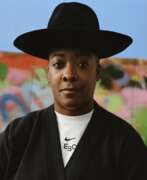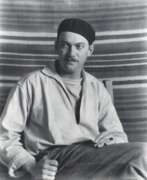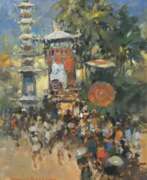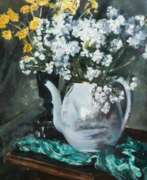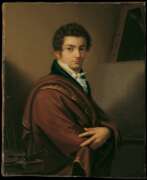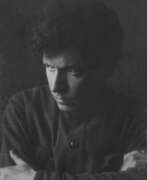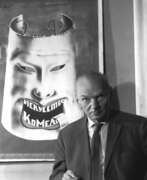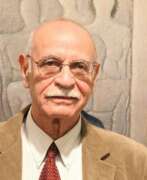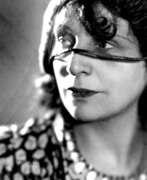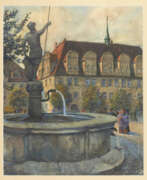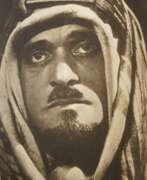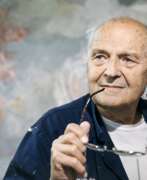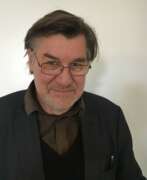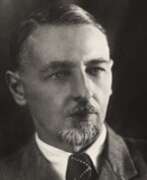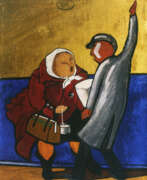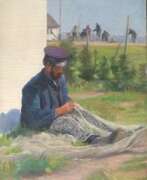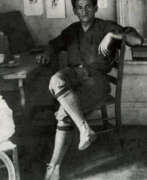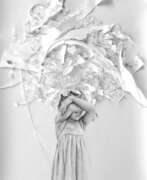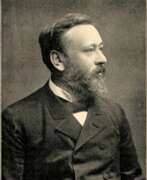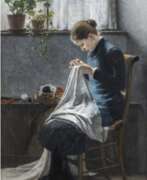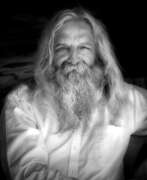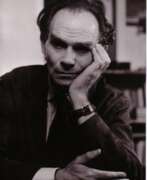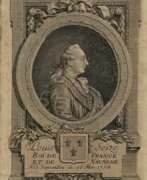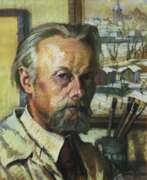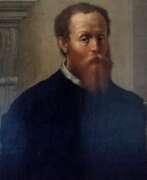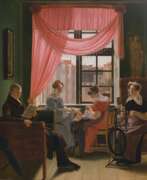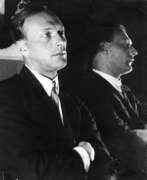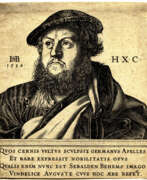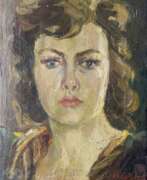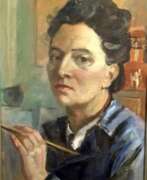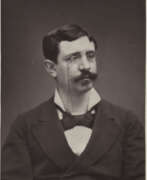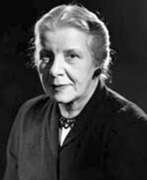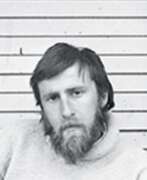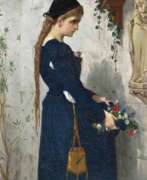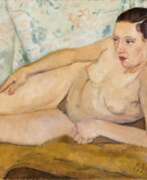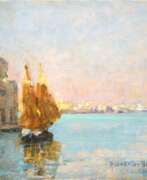Graphic artists Portrait
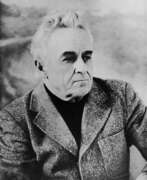

Alexander Grigorievich Maksymenko (Russian: Александр Григорьевич Максименко) was a Soviet and Ukrainian painter of the second half of the twentieth and early twenty-first centuries. He is known as a painter, graphic artist, watercolorist, and art historian.
Alexander Maksymenko worked in the genres of still life, landscape, portrait, as well as in genre painting. His genre works cover themes of collective farm life, including "Masters of the Land" and "Innovators of Collective Farm Fields". For the latter work he received the Stalin Prize. The master actively participated in exhibitions in Ukraine and abroad. His works are in the National Art Museum of Ukraine, the Museum of the History of Ukraine in World War II, as well as in other art museums and private collections.
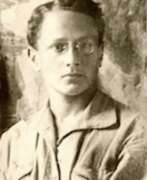

Pavel Efimovich Ab (Russian: Павел Ефимович Аб) was a Russian Soviet artist, born on November 22, 1902, in Orel. He is renowned for his contributions to painting and graphic arts, having studied under notable mentors such as Kuzma Petrov-Vodkin and A. I. Savinov at the VKhUTEIN in Leningrad during the years 1923 to 1929.
Ab's career was deeply influenced by his experiences during the Great Patriotic War, where he served in the 21st Rifle Division of the NKVD on the Leningrad Front. His war-time sketches of city defenders and subsequent military honors played a significant role in his artistic expression. After the war, he continued to actively participate in the creative community, producing notable works like "Pavlov in Koltushi" and "Speech of V. I. Lenin at the Admiralty Shipyards".
His artworks, which often depicted military and historical themes, are preserved in various museums and private collections in Russia and abroad. Ab's commitment to the Leningrad Union of Artists until his death in 1974 ensured that his legacy would influence future generations of artists.
For enthusiasts and collectors keen on exploring Russian Soviet art, staying updated on exhibitions and sales featuring Pavel Efimovich Ab's works can be enriching. Sign up here for updates related to new product sales and auction events concerning Ab's art.
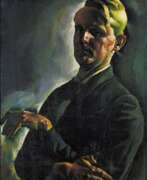

Vilmos Aba-Novák was a distinguished Hungarian artist, celebrated for his unique blend of Expressionism with classical and Renaissance influences. Born in Budapest in 1894, he was deeply influenced by his experiences in the Austro-Hungarian Army during World War I, which later permeated his art. Aba-Novák is best known for his vibrant frescoes and murals that decorate several public buildings in Hungary, including churches and civic buildings in Szeged and Budapest.
His works, characterized by dynamic compositions and a bold use of color, often depicted village fairs, circuses, and everyday Hungarian life, bringing an almost fantastical quality to these scenes. His remarkable ability to combine traditional subjects with modern artistic elements made his work a significant contribution to modern Hungarian art. Aba-Novák's art was not only appreciated in his homeland but also internationally, earning him major awards like the Grand Prize at the Paris World Exhibition in 1937 and at the 1940 Venice Biennale.
For art collectors and enthusiasts interested in exploring or purchasing Vilmos Aba-Novák's works, staying informed about upcoming sales and exhibitions is crucial. Signing up for updates can provide valuable insights into available pieces and auction events. To keep abreast of such opportunities, consider registering for newsletters or alerts specifically tailored to Aba-Novák's art. This will ensure you don't miss out on acquiring a piece of this unique artistic heritage.
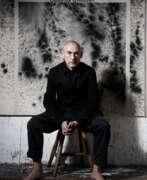

Hans Peter Adamski is a German painter and graphic artist who lives and works in Berlin and Dresden.
He studied at the Dusseldorf Academy of Art and served as professor and dean of the Dresden University of Fine Arts. Adamski is one of the most important representatives of the Neue Wilden ("New Wilden") movement of the 1980s. In addition to painting, he works in drawing, sculpture, paper, fabric and plaster.
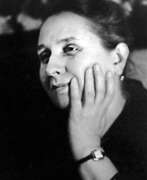

Taisia Kirillovna Afonina (Russian: Таисия Кирилловна Афонина) was a Soviet artist of the second half of the twentieth century. She is known as a painter, graphic artist, representative of the Leningrad school.
Taisia Afonina participated in exhibitions since 1940, creating portraits, landscapes, genre compositions, still lifes and etudes. At the beginning of her career she was interested in military subjects, and then delved into the genre of portraiture and lyrical landscape. Her style is characterized by tonal painting, the rendering of light and air environments and subtle coloristic combinations. In the 1980s she preferred the watercolor technique, painting flowers such as roses, daisies and tulips. Her works are in museums and private collections in Russia and other countries.
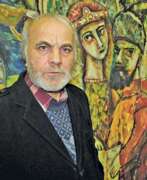

Vladimir Ivanovich Akulov (Russian: Владимир Иванович Акулов) is a Soviet and contemporary Belarusian artist. He is known as a painter, graphic artist and teacher, a representative of the second wave of Belarusian avant-garde.
Vladimir Akulov in his work has developed a unique style under the influence of expressionism, cubism, primitivism, fauvism. He is a master of portrait, landscape, still life, compositions with symbolic and allegorical subjects, illustrations of literary works. During his career the artist created several cycles of portraits, including those of famous people.
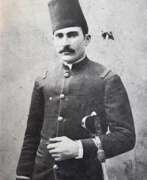

Abdul Qadir Al Rassam was an Iraqi painter of the first half of the twentieth century. He is known as a painter and graphic artist and is considered the founder of modern Iraqi painting.
Al Rassam, a military officer by training, studied drawing at the Military College in Istanbul. Returning to Iraq, he created landscapes, portraits and murals. His work is characterized by historical and ethnographic accuracy. The master, according to critics, contributed to the influence of the European academic school on the Iraqi art scene.
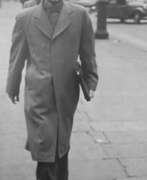

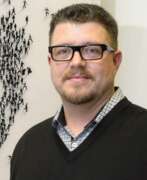

Craig Alan is an American artist whose work displays a technical sophistication as well as a rich imagination.
After moving with his family to New Orleans, Alan worked as a street artist in his youth, creating portraits. Through his exceptional talent and through his own research, he eventually developed an admirable understanding and sense of textures, compositions and colors. Today, Craig Alan represents a wide range of artistic styles, from book illustration to naturalistic oil painting and his Populus Art.
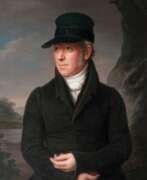

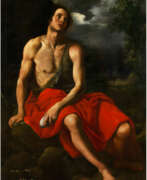

Cristofano Allori was an Italian painter of the late Florentine Mannerist school, painting mostly portraits and religious subjects. Allori received his first lessons in painting from his father, Alessandro Allori, but becoming dissatisfied with the hard anatomical drawing and cold coloring of the latter, he entered the studio of Gregorio Pagani. When still young he became a court portraitist for the Medicis, though many of his commissions were replicas of portraits by his predecessor Bronzino, or had participation by others.[citation needed. His pictures are distinguished by their close adherence to nature and the delicacy and technical perfection of their execution. His most famous work, in his own day and now, is Judith with the Head of Holofernes.
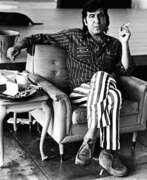

John Altoon was an American painter and representative of Abstract Expressionism. He was an important figure in Los Angeles art in the 1950s and 1960s.
He studied at the Otis Art Institute and simultaneously attended the Los Angeles Art Centre College of Design. Known for figurative works, he was a member of the Ferus group with Edward Kienholz and Robert Irwin. He suffered from schizophrenia from an early age and in fits of depression and paranoia destroyed some of his work.
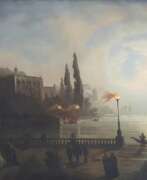

Gustav Adolf Amberger was a German painter and graphic artist. He lived in Rome for two years and learned the painting trade from Peter von Cornelius. One of his first works was the painting The Oceanides. Amberger worked as a designer in the ribbon factory founded by Philipp Trüdinger. Around 1870 he was the court painter to the Landgrave of Hesse. In Antwerp he was a pupil of Joseph van Lerius and made numerous copies, of which Les deux voies is the best known.
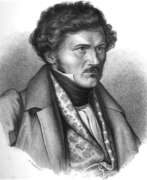

Samuel Amsler is a Swiss engraver. He studied his art under Johan Heinrich Lips and Karl Ernst Hess, at Munich, and from 1816 pursued it in Italy, and chiefly at Rome, till in 1829 he succeeded his former master Hess as professor of engraving in the Munich academy. The works he designed and engraved are remarkable for the grace of the figures, and for the wonderful skill with which he retains and expresses the characteristics of the original paintings and statues. He was a passionate admirer of Raphael, and had great success in reproducing his works.
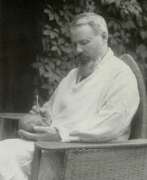

Nikolay Andreyevich Andreyev (Russian: Николай Андреевич Андреев) was a distinguished Russian sculptor, graphic artist, and stage designer, whose works have significantly contributed to the artistic landscape of early 20th-century Russia. Born into the rich cultural milieu of Moscow in 1873, Andreyev emerged as a pivotal figure associated with the Peredvizhniki group, a movement that sought realism and social critique through art. His early education under Sergey Volnukhin paved the way for a career that spanned various forms of artistic expression, including sculpture and graphic design.
Andreyev's works are known for their dynamic representation of figures and profound social commentary. Perhaps his most famous creation is the bronze statue of the celebrated writer Nikolai Gogol, unveiled in 1909. This statue, surrounded by bronze friezes depicting Gogol's characters, initially stood on Gogol Boulevard in Moscow. Its impressionistic style, however, attracted criticism, leading to its relocation in 1952. Another notable work, the "Woman reaper with a child," showcases Andreyev's adeptness at capturing the essence of Russian cultural symbols through sculpture. Cast in bronze, this work reflects Andreyev's ability to convey complex themes such as motherhood and labor with sensitivity and depth.
In his later years, Andreyev's artistic direction veered towards Socialist Realism, producing a prolific array of Leniniana - sculptures and graphic works of Vladimir Lenin. His commitment to this genre was profound, with around 100 sculptures and 200 graphic works dedicated to Lenin, marking a significant contribution to Soviet artistic propaganda. Additionally, his portrait of Lev Tolstoy stands as a testament to his versatility and depth as an artist, capturing the essence of the literary giant with striking realism.
Andreyev's legacy extends beyond his artistic achievements, with his works residing in prestigious collections such as the Tretyakov Gallery. His death in 1932 marked the end of a vibrant chapter in Russian art history, but his contributions continue to be celebrated for their artistic merit and historical significance.
For collectors and experts in art and antiques, the works of Nikolay Andreyevich Andreyev offer a unique glimpse into the cultural and political nuances of Russia during a transformative era. His sculptures not only stand as remarkable feats of artistic expression but also as enduring symbols of Russia's rich cultural heritage.
If you're intrigued by Andreyev's profound contributions to art and wish to explore his works further, consider signing up for updates. This subscription will keep you informed about new product sales and auction events related to Nikolay Andreyevich Andreyev, offering exclusive insights into the world of art and antiques.


Valery Vladimirovich Androsov (Russian: Валерий Владимирович Андросов) is a Soviet and contemporary Russian artist. He is known as a sculptor, architect, designer, painter, graphic artist and teacher.
Valery Androsov creates landscapes, still lifes and portraits, as well as fantasy works. He is also known as the author of a large collection of ex-libris that accurately convey the character and interests of book owners. At different periods he served as chief artist of the Mosstroiplastmass Combine and director of the Mytishchi Picture Gallery. He also created monuments to those who died in the Great Patriotic War and to the pilots of the Mytishchi Aero Club, showing his skill in various artistic directions.
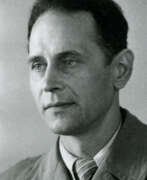

Vladislav Leopoldovich Anisovich (Russian: Владислав Леопольдович Анисович) was a Soviet artist of the mid-twentieth century. He is known as a painter, graphic artist and teacher, a representative of the Leningrad school of painting.
Vladislav Anisovich participated in various exhibitions since 1935. His work included portraits, historical and genre compositions, as well as landscapes. Among the famous paintings of the artist are "The passage of K. Voroshilov's detachment from Lugansk to Tsaritsyn", "Assault on Perekop" and others. The master taught at the Leningrad Institute of Painting, Sculpture and Architecture.
His works are in various museums and private collections in many countries, including the State Russian Museum.
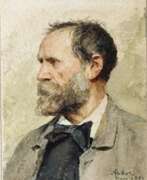

Albert Samuel Anker was a Swiss painter, gesture painter and graphic artist.
Albert studied at the École Nationale Supérieure des Beaux-Arts in Paris and exhibited his work at the Paris Salons, where he was awarded a gold medal in 1866. Anker painted many realistic portraits and genre scenes of ordinary Swiss life. In many of them he depicted children, including his own. Thanks to his paintings, Albert Anker was the most popular genre painter of 19th century Switzerland. He also decorated more than 500 earthenware plates for the Alsatian ceramicist Theodor Deck.
Anker was a member of the Grand Council of the Canton of Bern, initiated the creation of the city museum, and held the rank of officer of the Legion of Honor.
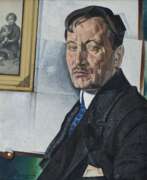

Yury Pavlovich Annenkov (Russian: Юрий Павлович Анненков) was a prominent Russian artist, renowned for his avant-garde book illustrations and portraits, as well as his work in theater and cinema. Born in 1889 in Petropavlovsk, Russian Empire, and passing away in 1974 in Paris, France, Annenkov's artistic journey was shaped by the tumultuous times he lived in. His work is celebrated for capturing the essence of an era marked by revolution and change, employing a style that is both dynamic and reflective of the Synthetism movement, emphasizing the synthetic essence of his subjects.
Annenkov's early years were spent in St. Petersburg, where he was influenced by prominent figures and movements of the time. He honed his skills in Paris, working in the studios of Maurice Denis and Félix Vallotton, and later, his talents led him to design iconic works for the Bolshevik government, such as the staging of "The Storming of the Winter Palace". His acclaimed book "Portraits," published in 1922, featured 80 pictures of key Russian art figures, showcasing his exceptional talent in capturing personalities through his art.
In 1924, Annenkov left Soviet Russia, eventually settling in Paris, where he continued to flourish as an artist, working on landscapes, female portraits, interiors, and achieving success in the film industry as a costume designer, notably receiving an Academy Award nomination for his work.
Among his notable works are "Dreams of a Provincial (Borovichi)," "Portrait of Elena Borisovna Annenkova," "June. Forest," "Portrait of Miron Abramovich Sherling," "Portrait of A.M. Gorky," and the "Illustration for the poem 'The Twelve' by A.A. Blok," each piece highlighting his ability to blend academic drawing with avant-garde techniques.
For collectors and art and antiques experts, Annenkov's works offer a glimpse into the rich tapestry of 20th-century Russian art, marked by its innovation, depth, and historical significance. His legacy continues to inspire and captivate audiences worldwide.
To stay updated on sales and auction events featuring Yury Pavlovich Annenkov's work, sign up for our newsletter. This subscription ensures you'll be the first to know about new product sales and auction events related to this remarkable artist.
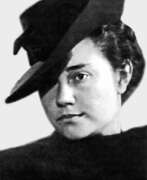

Evgenia Petrovna Antipova (Russian: Евгения Петровна Антипова) was a notable Russian painter, graphic artist, and art teacher. She stood out for her genre compositions, portraits, landscapes, and still lifes, primarily utilizing oils and watercolors. Evgenia Antipova's works often depicted apple orchards and Crimean landscapes, showcasing her profound connection to nature and her ability to capture its essence.
Evgenia Antipova's education at the prestigious Repin Institute of Arts shaped her artistic journey, leading to a career enriched with personal exhibitions and a significant presence in the art community. Not only did her artworks gain recognition in Russia, but they also found their way into international collections and exhibitions, notably in France, Germany, the United States, and the United Kingdom.
Throughout her career,Evgenia Antipova was an active participant in various significant exhibitions, displaying her works alongside other renowned artists. Her contributions to the art world were recognized with personal exhibitions in Saint Petersburg and inclusion in art auctions and exhibitions abroad.
Evgenia Antipova's paintings are part of prestigious collections, including the State Russian Museum, and continue to be celebrated in art museums and private collections globally. Her legacy as a prominent figure in the Leningrad School of painting endures, captivating art enthusiasts and collectors with her vivid and emotionally resonant works.
For those interested in Russian art, particularly the Leningrad School of painting, Evgenia Petrovna Antipova's oeuvre offers a rich exploration of genre compositions and landscapes, reflecting the artistic vibrancy of her era. Collectors and art experts are encouraged to delve into her works and consider signing up for updates on exhibitions and sales featuring her paintings.
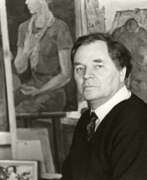

Fyodor Vasilievich Antonov (Russian: Фёдор Васильевич Антонов) was a Soviet and Russian artist of the twentieth century. He is known as a painter, graphic artist, textile artist, teacher, and professor.
Fyodor Antonov created landscapes, portraits and thematic compositions. In his genre works he immortalized the life and life of Soviet youth, as well as the formation of industry in the USSR. During the Great Patriotic War, the artist created portraits of heroes, as well as posters with a simple and direct pictorial form. Antonov's works are in various museum collections, including the Tretyakov Gallery, the Russian Museum and many private collections.


Christiaan Karel Appel was a Dutch painter, sculptor, and poet. He started painting at the age of fourteen and studied at the Rijksakademie in Amsterdam in the 1940s. He was one of the founders of the avant-garde movement CoBrA in 1948. He was also an avid sculptor and has had works featured in MoMA and other museums worldwide.


Anatoly Afanasyevich Arapov (Russian: Анатолий Афанасьевич Арапаов) was a Russian and Soviet artist, born in St. Petersburg in 1876 and passing away in Moscow in 1949. His artistic journey began after graduating from high school in 1892, leading him to study at the Moscow Boundary Institute where he initially acquired artistic skills. Arapov's dedication to art became undeniable, prompting him to enroll in the Moscow School of Painting, Sculpture and Architecture in 1897, where he was deeply involved in applied art, book design, and theater.
Arapov's early works, particularly around 1900 and 1910, were influenced by Symbolism, but he transitioned through a phase of Constructivism in the 1920s before dedicating himself to Socialist Realism from the 1930s onward. His versatile talent spanned across painting, graphic arts, and set design, making significant contributions to theater and film. Notably, he designed plays for leading theaters across major Russian cities and worked on popular films in the 1920s and 1930s.
His oeuvre includes portraits, still lifes, and landscapes, featuring views of ancient parks and Russian architecture. Arapov's works are celebrated for their stylistic diversity, capturing the essence of Symbolism, Constructivism, and Socialist Realism. His contributions are recognized in museum collections, including the State Tretyakov Gallery and the Saratov State Art Museum named after Radishchev, among others.
For collectors and art experts, Arapov's works offer a glimpse into the evolving art styles of early to mid-20th century Russia. To stay informed on sales and auction events featuring Anatoly Afanasyevich Arapov's art, signing up for updates can provide exclusive access to new discoveries and opportunities to acquire pieces by this multifaceted artist.
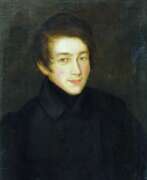

Nikolai Ivanovich Argunov (Russian: Николай Иванович Аргунов) was a Russian painter of the late 18th - the first third of the 19th centuries. He is known as a painter, graphic artist, miniaturist, representative of Russian classicism.
Nikolai Argunov is considered one of the greatest portrait painters of his time. His works are notable for their diversity, psychologism, objective approach to nature, devoid of classicist idealization and romantic heroization of the models.
The artist was a serf, was granted his freedom after the death of his master and became an academician of the Imperial Academy of Arts in St. Petersburg. He was a member of a dynasty of artists, the beginning of which began with his father Ivan Argunov.
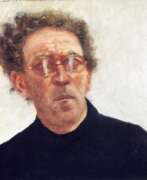

Avigdor Arikha (Hebrew: אביגדור אריכא) was a Romanian-born French–Israeli artist, printmaker and art historian.
Arikha painted directly from the subject in natural light only, using no preliminary drawing, finishing a painting, pastel, print, ink, or drawing in one session. His profound knowledge of art techniques and masterly draughtsmanship enabled him to abide by this principle of immediacy, partly inspired by Chinese brush painting.
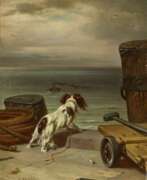

Carl Johann Arnold was a German painter, draftsman, and graphic artist.
He was the son and pupil of the designer and wallpaper maker, landscape and portrait painter, lithographer, and decorator Carl Heinrich Arnold (1793-1874).
He first studied at the Academy in Kassel and then went to Berlin. Carl Johann Arnold painted pictures of animals, canvases on historical events, and numerous portraits. In particular, he created many portraits of the German Emperor Wilhelm II, for which he was apparently appointed royal Prussian court painter. Arnold also produced drawings, etchings, and lithographs that were published in the popular magazines of the time.
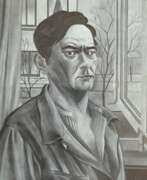

Christian Arnold was a German painter and graphic artist. He is best known for his landscape paintings that often depicted the rural and coastal regions of northern Germany.
Arnold studied at the Academy of Fine Arts in Munich and later taught at the School of Arts and Crafts in Bremen. His work was heavily influenced by the German Expressionist movement, and he often used bold colors and thick brushstrokes to create a sense of emotional intensity in his paintings.
In addition to his landscapes, Arnold also produced numerous portraits, still lifes, and religious works. He worked in a variety of mediums, including oil paints, watercolors, and printmaking.
Arnold's work was exhibited widely during his lifetime, and he received numerous awards and honors for his contributions to the arts. Today, his paintings are held in collections around the world, including the National Gallery in Berlin and the Kunsthalle Bremen.
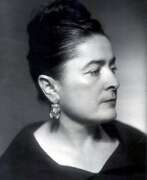

Yeranui Arshakovna Aslamazyan (Russian: Ерануи Аршаковна Асламазян) was a Soviet and Russian artist of the second half of the twentieth century of Armenian origin. She is known as a painter and graphic artist.
Yeranui Aslamazyan created portraits, landscapes, still lifes and genre paintings. She also experimented with theater design, prints and ceramics. An Orientalist artist, she was part of the Soviet artistic elite in Leningrad and Moscow. With the support of the Soviet Union authorities, she traveled the world, visiting many countries. Her works are in museums in London, Sofia, Berlin, St. Petersburg, Venice, Tokyo, and Delhi.


Mariam Arshaki Aslamazyan (Russian: Мариам Аршаковна Асламазян) was a renowned Soviet-Armenian painter, often hailed as the "Armenian Frida Kahlo" due to her vibrant and expressive works that prominently featured elements of Armenian culture. Born on October 20, 1907, in Alexandropol (now Gyumri), Armenia, Aslamazyan was celebrated for her unique style which blended traditional Armenian themes with modernist influences.
Throughout her career, Aslamazyan's artwork received significant accolades, including the prestigious titles of People's Artist of the Armenian SSR in 1965 and People's Artist of the Soviet Union in 1990. Her paintings are characterized by their vivid colors and dynamic compositions, often focusing on still lives, narrative scenes, and portraits.
Aslamazyan's works are preserved and displayed in several major collections, notably at the Gallery of Mariam and Eranuhi Aslamazyan Sisters in her hometown, which showcases an extensive array of her oil paintings and ceramic works. Her artistic legacy continues to be celebrated in exhibitions and holds a significant place in Armenian cultural heritage.
For those interested in exploring more about Mariam Arshaki Aslamazyan's life and art, or in acquiring works associated with her, consider subscribing for updates on new product sales and auction events related to her work. This subscription will keep you informed about opportunities to engage with Aslamazyan's art legacy.
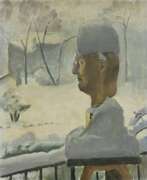

Maurice Paul Jean Asselin was a French painter, watercolourist, printmaker, lithographer, engraver and illustrator, associated with the School of Paris. He is best known for still lifes and nudes. Other recurring themes in his work are motherhood, and the landscapes and seascapes of Brittany. He also worked as a book illustrator, particularly in the 1920s. His personal style was characterised by subdued colours, sensitive brushwork and a strong sense of composition and design.
He was awarded the rank of Officier de la Légion d'honneur in 1939.
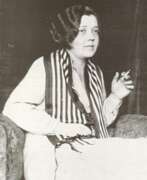

Zinaida Antonovna Astapovich-Bocharova (Russian: Зинаида Антоновна Астапович-Бочарова) was a Russian, Soviet and Belarusian artist of the twentieth century. She is known as a painter, graphic artist and teacher.
Zinaida Astapovich-Bocharova worked in the genres of portrait, landscape, propaganda poster, as well as book illustration - mainly for fairy tale books. She painted in watercolor, oil, pencil, charcoal, gouache, and pastel. Much of her work from the 1930s and 1940s was lost during the evacuation of the artist from besieged Leningrad.
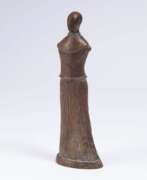

Edgar Augustin was a German painter and sculptor.
Augustin studied sculpture in Münster with Karl Ehlers, then was a pupil of the master Gustav Zeitz in Hamburg. His oeuvre includes partly abstract figurative representations in bronze, wood and plaster as well as paintings, drawings and graphics. Some of Edgar Augustine's sculptures are located in public spaces in Hamburg and other cities.
Edgar Augustin was a member of the Free Academy of Arts in Hamburg and the Special Association of Artists in Germany. In the second half of the 20th century, Augustin was one of the pioneers of figurative wood sculpture and is considered its most important representative.
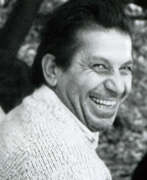

Robert Petrosovich Avakyan (Russian: Роберт Петросович Авакян) was a Soviet and Uzbek artist of the second half of the twentieth and early twenty-first centuries of Armenian origin. He is known as a painter, graphic artist, sculptor and teacher.
Robert Avakyan was trained in painting, but he is most famous as an author of monumental sculptures. He worked actively in Tashkent, participating in numerous exhibitions, including international sculpture competitions. The master also left his mark in such Uzbek cities as Bukhara, Nukus and Yangibazar, where he created significant monumental works.


Vsevolod Grigorievich Averin (Russian: Всеволод Григорьевич Аверин) was a Ukrainian Soviet graphic artist and book illustrator. He was one of the most important Ukrainian animal painters of the first half of the 20th century, incorporating avant-garde techniques into his work.
Averin worked in book and easel graphics, especially lithography, as well as portrait and landscape painting. He illustrated many well-known works, including the Atlas of Human Anatomy and a novel by M. Twain. His work was characterised by an exquisite style and harmonious design, and his estate includes some 300 bindings, 3,000 illustrations and 90 posters.
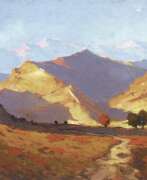

Gennady Fyodorovich Babikov (Russian: Геннадий Фёдорович Бабиков) was a Soviet and Turkmen artist of the twentieth century. He is known as a painter, graphic artist, watercolorist, master of landscape and still life and is considered the founder of the genre of Turkmen industrial landscape, representative of the Russian academic school of painting in Central Asia.
Gennady Babikov participated in the Great Patriotic War, at the front he created more than 100 graphic portraits of fellow soldiers. The artist was famous for his linocuts, and also developed a still life style, which was called "Babikov's" in Turkmenistan.
His works are in many private collections around the world.


Stanislav Gennadievich Babikov (Russian: Станислав Геннадьевич Бабиков) was a Soviet and Turkmen artist of the mid-twentieth century. He is known as a painter, graphic artist, publicist, scenographer, as well as the son and pupil of Gennady Babikov, the founder of the Turkmen industrial landscape genre.
Stanislav Babikov is considered a continuator of the ideas of Russian Cezannism. He was a member of the informal Turkmen group "Seven", which sought to synthesize national elements and Western modernism in art. The master was also an author of articles on fine arts. His style reflects the influence of nature and climate of Turkmenistan and is characterized by bright color and expressiveness of color.
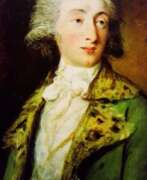

Carl Daniel David Friedrich Bach was a German artist of the late eighteenth and early nineteenth centuries, the Baroque period. He is known as a painter, graphic artist and printmaker.
Bach worked in the historical genre, was a portraitist, animalist, created canvases on allegorical subjects in the spirit of his era. In his works he combined elements of baroque and classicism. The artist often worked in the etching needle technique.


Aino Bach (Russian: Айно Густавовна Бах) was an Estonian and Soviet artist of the twentieth century. She is known as a painter, graphic artist and printmaker.
Aino Bach was one of the first Estonian printmakers to demonstrate mastery of the intaglio technique, which expanded the possibilities of engraving. Her work includes portraits, genre compositions and illustrations. She employed a variety of techniques including gravure printing, metal engraving, and color monotype. Her works often combined different techniques, giving them a distinctive flavor.
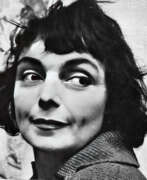

Bele Bachem (real name Renate Gabriele Bachem) was a German painter, graphic designer, book illustrator, interior designer and writer. In 1997 Bachem was awarded the Order of Merit of the Federal Republic of Germany.
Bachem is considered one of the most important post-war German artists and one of the few surrealists in the illustration of German literature.
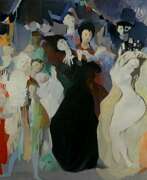

Karl Otto Bachmann, a Swiss painter, graphic artist, and illustrator, began his artistic career in Luzern before moving to Zurich and pursuing freelance work. He achieved a breakthrough in 1943 with the publication of his "Faust" portfolio. Bachmann drew inspiration from his travels across Europe, often joining circus troupes for income and creative ideas. His paintings were characterized by imaginative and virtual settings, with themes revolving around the stage, carnival, and circus. Bachmann's elegant lines, delicate colors, and harmonious compositions made him a respected book illustrator. He actively participated in numerous exhibitions throughout his life, both domestically and internationally.
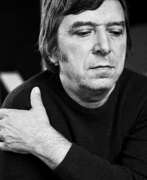

Hermann Bachmann is a German artist, graphic designer and teacher.
Hermann studied at the School of Applied Arts Offenbach am Main and served in the army during World War II. In 1945, Bachmann returned to his hometown and joined the artists of the Halle School. And in 1953 he fled to West Berlin, whose creative atmosphere was closer to him.
In 1957 Hermann Bachmann became a teacher and later a professor at the University of Fine Arts in Berlin, among his students many famous artists. He was a member of the Association of German Artists.
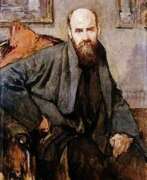

Albert Baertsoen was a Belgian painter, pastellist and graphic artist. His debut as a painter came in 1887, when he participated in an exhibition in Brussels held by the secessionist group l'Essor. He continued his studies in Paris, at the art school of Alfred Philippe Roll, and exhibited at the Salon in 1889. In 1894, he helped found the "Cercle des Beaux-Arts d'Ostende". From 1896 to 1901, he continued to exhibit throughout Europe, winning several Gold Medals. In 1913, he served as a member of the art jury for the Ghent World's Fair. During World War I, he lived in London, returning to Ghent in 1919. That same year, he was appointed a member of the Royal Academy of Belgium.
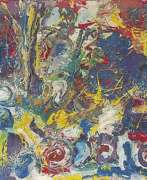

Ernst Rudolf Baerwind was a German painter. Baerwind studied at the art academies in Munich, Berlin and Paris. Baerwind's work was initially based on early German Expressionism. After a surrealist phase, he was influenced in Paris by the painting of the École de Paris and by Informel and then found his way to the International Style.
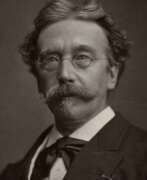

Alexander Hugo Bakker Korff was a 19th-century Dutch genre painter. He was a pupil of the painters Cornelis Kruseman and Huib van Hove. He was trained in the 1840s at the Koninklijke Academie van Beeldende Kunsten in the Hague and the Koninklijke Academie. He became known for his "Bakker Korffjes" – genre pieces of ladies in caps in interiors, that he started painting in 1856 while he was living in Oegstgeest with his sisters as models. In 1870 he was awarded the title ridder in de Leopoldsorde after his works were presented at an exhibition in Brussels in 1869.


Leonid Fyodorovich Balaklav (Russian: Леонид Фёдорович Балаклав) is a Soviet and contemporary Israeli artist. He is known as a painter, graphic artist and cartoonist.
Leonid Balaklav began his career in Kishinev, then moved to Kiev, where he worked on scientific films. In 1987 at the Tokyo Film Festival he was awarded a gold medal for his animated works. In 1989 he moved to Israel, where he became known for his portraits, lyrical landscapes and works on religious themes. His work is often associated with Jewish identity, and his paintings are known for their intimacy and detail. He uses oil paints on wood to create his works.


Hans Baluschek, full name Alphons Anton Alexander Hans Ernst Karl Maria Baluschek, was a German painter, graphic artist and writer, representative of the New Materiality style.
Baluschek studied at the Royal Academy of Arts, and in 1900 became a member of the Berlin Secession, a group of artists that also included Ernst Barlach, Max Beckmann, and Wassily Kandinsky. Baluschek was always socially critical, which was reflected in the subjects of his paintings. Many of his paintings are dedicated to the working class of Berlin, he addressed the gray everyday life of Berlin: gray air, gray walls, gray people. Baluschek is often categorized as a German Expressionist because of his emotional style, but his style has something of New Objectivity, Impressionism, and naive painting. He also drew illustrations for the popular children's book Little Peter's Trip to the Moon, and collaborated with periodicals as an illustrator.
World War I instilled patriotic feelings in Baluschek, and he painted a number of subjects on this theme. After the war, he joined the Social Democratic Party and became involved in labor movements. In 1926 he helped establish an artists' relief fund and later became director of the annual Berlin Exhibition. The German Nazis, who came to power in 1933, declared Baluschek a Marxist and a "degenerate artist," suspended him from all positions, and banned him from exhibiting.
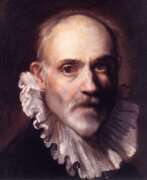

Federico Barocci, an Italian Renaissance painter and printmaker, was celebrated for his vibrant use of color and dynamic compositions. Born around 1533 in Urbino, Italy, a hub of Renaissance culture, Barocci's early life was steeped in the rich artistic heritage of the time. His training included an apprenticeship with his father, a sculptor, and later with notable artists such as Battista Franco Veneziano and Taddeo Zuccari.
Federico Barocci's work, known for its emotional intensity and use of light, positioned him as a critical link between the Mannerist style of the 16th century and the emerging Baroque period. His paintings often depicted religious scenes, imbued with a warmth and spirituality that resonated with viewers. His unique approach to color and composition had a significant influence on later artists, including the Baroque masters Peter Paul Rubens and Gian Lorenzo Bernini.
Despite suffering from chronic illness, possibly due to poisoning, Federico Barocci's output remained prolific and influential. His works can be found in several prestigious galleries, including the Uffizi in Florence, where his "Madonna del Popolo" and "Martyrdom of Saint Vitale" are displayed. These pieces, along with others like "The Deposition" in the Cathedral of Perugia and "Noli me Tangere" in Munich, showcase his mastery in portraying human emotion and divine radiance.
Collectors and experts in art and antiques will appreciate the depth and innovation of Federico Barocci's work. His legacy as a master colorist and draughtsman is undeniable, making his pieces a valuable addition to any collection.
To stay updated on sales and auction events related to Federico Barocci, sign up for our exclusive updates. This subscription ensures you're the first to know about new opportunities to acquire works connected to this remarkable artist.
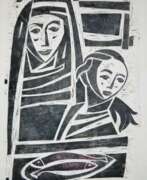

Carl Josef Barth was a German painter and graphic artist.
At the beginning of his artistic career Barth worked in the style of late expressionism, and later his works were attributed to the new objectivity and magical realism. Throughout his life, Barth changed from one style of painting to another. After World War II, the artist focused mainly on pessimistic subjects, ruins and hopelessness.
Carl Josef Barth's brother was the writer Emil Barth.
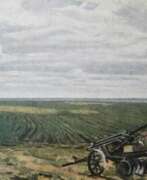

Vasily Nikolaevich Basov (Russian: Василий Николаевич Басов) was a Soviet artist of the mid-twentieth century. He is known as a painter, graphic artist, and representative of socialist realism in art. His oeuvre includes landscapes, portraits and genre paintings, with a special focus on rural subjects.
Since 1943 Vasily Basov actively participated in exhibitions, both national and international. His works have been exhibited in various countries, including Poland, China, Bulgaria and Romania.
Basov's works are in the collections of the State Tretyakov Gallery, the State Art Museum of the Altai Territory and other museums, as well as in private collections.
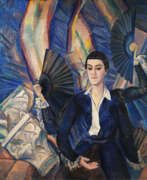

Elena Mikhailovna Bebutova (Russian: Елена Михайловна Бебутова) was a Russian and Soviet artist of the mid-twentieth century of Georgian-Armenian origin. She is known as a painter, graphic artist and scenographer.
Elena Bebutova evolved from a fascination with cubism and futurism in her early work to a more decorative and realistic style. In 1917, she began working on the decoration of performances in various theaters in Russia, and held a personal exhibition in Moscow in 1923. Returning to the USSR after business trips to Berlin and Paris, she became one of the founding members of the society "Four Arts". Her work in the theater was closely linked to the directing activities of her brother Valery Bebutova; their last collaboration was a production of Hamlet at the Vitebsk Belorussian Theater in 1946 and 1955.
Bebutova is also known as a model for portraits created by her husband Pavel Kuznetsov.
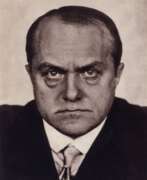

Max Beckmann, a German painter, printmaker, sculptor, and writer, stood out in the early 20th century for his profound contributions to modern art. Beckmann's career spanned a tumultuous period in history, deeply influencing his thematic and stylistic choices. Unlike many of his contemporaries who embraced non-representational painting, Max Beckmann persisted with and evolved the tradition of figurative painting, drawing inspiration from a wide array of artists spanning from Cézanne and Van Gogh to medieval masters like Bosch and Bruegel.
Max Beckmann's experiences, particularly those related to the World Wars, significantly shaped his work. Following Adolf Hitler's rise to power and the subsequent condemnation of modern art as "degenerate," Beckmann fled Germany, spending a decade in self-imposed exile in Amsterdam before eventually relocating to the United States. His art from this period, especially his large triptychs, is considered some of his most potent, offering a stark reflection on humanity and the chaos of the times.
One of Max Beckmann's most personally allegorical works, "Beginning" (1949), encapsulates his knack for blending real and imagined elements from his life to comment on the broader human condition. This piece, alongside others, underscores Beckmann's enduring fascination with the existential struggles modern society faces, teetering between desire and societal roles.
Max Beckmann's legacy is cemented not just by his unique approach to modernism but also by his influence on subsequent generations of artists, particularly in the United States, where he spent his final years teaching and working. Despite a path that often diverged from the mainstream narratives of art history, Beckmann's work continues to resonate, housed in prestigious institutions like The Museum of Modern Art and The Metropolitan Museum of Art in New York.
For collectors and experts in art and antiques, Max Beckmann's oeuvre offers a compelling exploration of 20th-century art and history. To stay informed about new discoveries, sales, and auction events related to Max Beckmann, consider signing up for updates. This subscription ensures access to the latest opportunities to engage with the work of one of modernism's most individual voices.


René Beeh was a German painter, graphic artist and draftsman born in Alsace, France.
René Beeh studied at the School of Fine Arts in Strasbourg, then at the Academy of Fine Arts in Munich. In 1910 he traveled to Algeria, resulting in the publication of a collection of letters with many drawings entitled M'Barca. He also illustrated several books and periodicals.
Beeh was a member of the New Munich Secession. The talented artist was highly respected among his contemporaries and was expected to have a great future, but unfortunately his early death interrupted these plans.


Karl Petrovich Beggrov (Russian: Карл Петрович Беггров) was a Russian artist known for his exceptional lithographs and watercolor paintings. Born in 1799, Beggrov studied at the St. Petersburg Academy of Arts under M.N. Vorobyov and later worked in his brother's lithographic workshop. His talent spanned various art forms, including portraits, landscapes, and cityscapes, which captured the essence of 19th-century St. Petersburg.
Beggrov's work is particularly celebrated for its detailed and vivid portrayals of St. Petersburg. His series "Views of St. Petersburg and Its Environs," created between 1821 and 1826, remains one of the most significant contributions to early Russian lithography. These works were a collaborative effort with other artists, yet Beggrov's distinctive style is evident in the 28 lithographs he produced for the series.
Several of Beggrov's artworks are housed in major museums, including the Metropolitan Museum of Art. Notable pieces like "Our Lady of Vladimir Church in St. Petersburg" and "View of the Arch of the General Staff Building Towards the Winter Palace" showcase his mastery of lithography and his ability to convey architectural grandeur with precision.
For collectors and art enthusiasts, staying updated on Karl Petrovich Beggrov's works is essential. Subscribe to our updates for notifications on new product sales and auction events related to Beggrov's art.
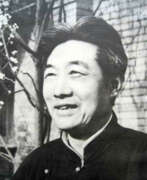

Xu Beihong (Chinese: 徐悲鴻; Wade–Giles: Hsü Pei-hung; 19 July 1895 – 26 September 1953), also known as Ju Péon, was a Chinese painter.
He was primarily known for his Chinese ink paintings of horses and birds and was one of the first Chinese artists to articulate the need for artistic expressions that reflected a modern China at the beginning of the 20th century. He was also regarded as one of the first to create monumental oil paintings with epic Chinese themes – a show of his high proficiency in an essential Western art technique. He was one of the four pioneers of Chinese modern art who earned the title of "The Four Great Academy Presidents".
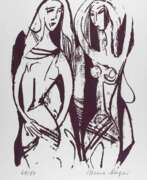

Maria Beine-Hager was a German artist and graphic artist.
She was brought up in a convent, was widowed early and later worked as a Red Cross nurse before beginning her artistic education in postwar Germany under Soviet academy professor Leonid Bordyuk and graphic artist Norbert Hochsiedler. Beine-Hager subsequently attended the Oskar Kokoschka International Summer Academy in Salzburg and established herself as a thoughtful graphic artist and painter at exhibitions at home and abroad.
Maria Beine-Hager's art has both strong religious and political undertones.


Vladimir Georgievich Bekhteev (Russian: Владимир Георгиевич Бехтеев) was a Russian artist and painter, born in 1878 and passing away in 1971. His journey into the art world led him from Russia to Munich on the advice of Sergei Jawlensky, where he was deeply influenced by the artistic and intellectual environment of the city, particularly through his connections with the Jawlensky household and the vibrant café culture. Bekhteev's early works, such as "Autumn Alley" (1905), showcase his assimilation of late Impressionist techniques and the influence of Van Gogh, reflecting a period of significant artistic development during his time in Germany.
Bekhteev's art gained recognition and was collected by prominent figures in the avant-garde art scene. His participation in exhibitions reflects a broad interest in various subjects, from landscapes to memories of Africa, demonstrating his versatility and curiosity as an artist. His works have been featured in international exhibitions and have fetched notable prices at auctions, indicating a continued interest and appreciation for his contributions to Russian and European art.
For collectors and experts in art and antiques, Bekhteev's works represent an intriguing intersection of Russian and European artistic movements in the early 20th century. His unique approach to color, form, and subject matter offers a distinctive perspective within the broader context of Impressionist and post-Impressionist art.
To stay updated on sales and auction events related to Vladimir Georgievich Bekhteev, signing up for updates is highly recommended. This subscription will ensure that enthusiasts and collectors are promptly informed of new opportunities to acquire pieces by this distinguished artist.


Victoria Markovna Belakovskaya (Russian: Виктория Марковна Белаковская) was a Russian Soviet artist of the mid-twentieth century. She is known as a painter, graphic artist and representative of the Leningrad school of painting.
Victoria Belakovskaya participated in exhibitions of Leningrad artists since the early 1930s. Her work covers various genres, including portraits, genre compositions, still lifes and landscapes. Her famous works include "Pioneer Girl" (1931), "Self-Portrait with a Cigarette" (1936), "Leningrad Landscape" (1953), "Spring Flowers. Still Life" (1961), a series of landscapes of Altai, Crimea, Kiev and others.
Works by the artist are in the collections of museums in Russia, Great Britain, USA, France and other countries.


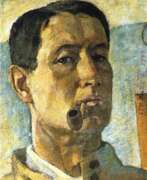

Veniamin Pavlovich Belkin (Russian: Вениамин Павлович Белкин), a distinguished Russian and Soviet artist, was born in 1884 and made significant contributions to the fields of painting, graphic arts, and teaching until his death in 1951. His extensive teaching career included positions at prestigious institutions such as the Higher Institute of Photos and Photo Equipment, the Baron A.L. Stieglitz Central School of Technical Drawing, Vhuteine, the State Architectural Institute, and the Leningrad Institute of Painting, Sculpture, and Architecture named after Ilya Repin. In 1955, a memorial exhibition in Leningrad posthumously honored his artistic legacy.
Belkin's artworks, characterized by their depth and artistic integrity, are held in high regard within major museum collections, including the State Tretyakov Gallery and the State Russian Museum, as well as various regional museums. His contributions to Russian art are celebrated for their historical and cultural significance, bridging the gap between pre-revolutionary and Soviet art.
For collectors and experts in art and antiques, Belkin's work represents an intriguing investment, embodying the rich tapestry of Russian history and culture. His legacy continues to inspire and influence contemporary art, making his pieces sought after by connoisseurs around the world.
Sign up for updates to stay informed about new product sales and auction events related to Veniamin Pavlovich Belkin, and enrich your collection with the works of one of Russia's most venerable artists.
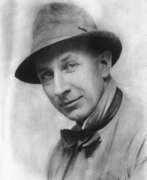

George Wesley Bellows was an American realist painter, renowned for his vivid portrayals of urban life in New York City. Born on August 12, 1882, in Columbus, Ohio, Bellows moved to New York in 1904, where he became a central figure in the Ashcan School of painting. This group was known for its realistic and often gritty depictions of everyday city life. Bellows captured dynamic scenes ranging from boxing matches to bustling street views, applying vigorous brushwork that conveyed movement and emotion.
One of Bellows' most celebrated series was his boxing paintings like "Stag at Sharkey’s," which encapsulate the raw, dynamic energy of illegal prizefights in early 20th-century New York. Beyond the ring, his works such as "New York" and "Pennsylvania Excavation" reflected the rapid transformations of urban landscapes. His adaptation of lithography also marked a significant contribution to American art, offering a new medium for expressive possibilities.
Bellows' art is preserved in major institutions such as the Metropolitan Museum of Art and the Museum of Modern Art in New York. His ability to depict the vibrancy and complexity of urban life makes his work a valuable part of American art history.
For updates on exhibitions and available works of George Wesley Bellows, consider subscribing to our newsletter. This subscription will keep you informed about new sales and auction events specifically related to Bellows' art.
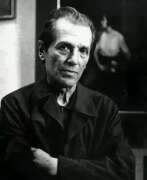

Piotr Petrovich Belousov (Russian: Пётр Петро́вич Белоу́сов) was a distinguished Soviet and Russian artist, born on May 3, 1912, in Berdyansk, and passed away on March 31, 1989, in Leningrad. He is widely celebrated for his contributions to the Leningrad School of Painting, having been an influential figure in shaping the artistic landscape of the region. His expertise extended across various mediums, including painting, etching, and graphic arts, with a notable focus on themes like the Bolshevik Revolution and historical Soviet figures like Lenin.
Belousov's educational and professional journey was deeply intertwined with the prestigious Ilya Repin Leningrad Institute of Painting, Sculpture and Architecture, where he both studied and later taught, eventually rising to the rank of professor and head of the drawing department by 1956. His career was marked by numerous accolades, including the titles of Honored Artist and People's Artist of the RSFSR, reflecting his significant impact on Russian art and education.
Throughout his life, Belousov participated in many exhibitions and his works are held in high esteem, not only in Russian state museums like the Russian Museum and the Tretyakov Gallery but also internationally. His pieces, particularly those that capture key moments in Soviet history and urban landscapes, remain influential and are sought after by collectors around the worl.
For enthusiasts of Soviet art and collectors interested in Belousov's works, staying updated on exhibitions and sales can provide valuable opportunities to acquire his art. To receive alerts about new product sales and auction events featuring Piotr Petrovich Belousov's works, signing up for updates is highly recommended.


Vasiliy Vasiliyevich Belyashin (Russian: Василий Васильевич Беляшин) was a distinguished Russian and Soviet artist, acclaimed for his contributions to the Silver Age of Russian art. Born on September 8, 1874, in Vilnius, within the Russian Empire, and passing on May 8, 1929, in St. Petersburg, USSR, Belyashin's career spanned the late 19th and early 20th centuries, a period marked by significant artistic evolution. His versatility as an artist is evident in his work as a portrait painter, landscape artist, printmaker, and illustrator, with a particular renown for his series of self-portraits.
Operating mainly within the impressionist style, Belyashin's artistry was not confined to a single genre. He excelled across various forms, including landscape painting, portraits, self-portraits, and still life, showcasing a broad skill set that resonated with the Symbolist and Impressionist movements of his time. His educational background and associations with artistic societies, such as the Kuindzhi Society, the Art Community, and the Partnership of Artists, further underline his integral role in the artistic community of his era.
Though detailed records of Belyashin's works in specific museums or galleries were not immediately available, the acknowledgment of his art in auctions and the recognition by cultural institutions suggest a lasting legacy. His work, celebrated for its emotional depth and technical proficiency, continues to capture the imagination of art collectors and enthusiasts alike.
For those intrigued by Vasiliy Vasiliyevich Belyashin's unique contribution to the world of art, staying updated on auctions and exhibitions featuring his work is invaluable. Signing up for updates related to Belyashin can ensure you remain informed about new sales and auction events, offering a chance to connect more deeply with this master's artistic journey.
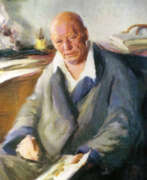

Pavel Petrovich Benkov (Russian: Павел Петрович Беньков) was a Russian and Soviet artist of the first half of the twentieth century. He is known as a painter, graphic artist, theater decorator, and teacher.
Pavel Benkov created portraits, landscapes, cityscapes, genre paintings. His style in his mature years can be described as impressionist, with attention to color and light. In 1929 he moved to Central Asia, where his style took on unique characteristics, reflecting local landscapes and culture. His work has had a significant influence on the painting traditions of Uzbekistan and Central Asia.
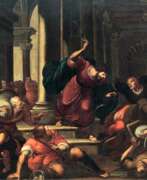

Giulio Benso was a Genovese painter of the early Baroque. He is known as one of the followers of the style of Luca Cambiasi. Initially under the patronage of Giovanni Carl Doria, he met Giulio Cesare Procaccini and was encouraged to study in the Genovese Accademia del Nudo. Afterwards, he was apprenticed to Giovanni Battista Paggi. Apart from his work in Liguria, he decorated the Palazzo Grimaldi in Cagnes-sur-Mer with the Fall of Phaeton and sent works to the Abbey of Weingarten in Germany. In the 1640s, he completed his masterpiece, a fresco in the presbytery and apse of the church of the Basilica della Santissima Annunziata del Vastato. There are also paintings of his in his hometown of Pieve di Teco as well as in the parish church of Sant'Ambrogio in Alassio.


Vilmos-József Istvanovich Berets (Russian: Вильмош-Йожеф Иштванович Берец) was a Ukrainian Soviet artist of the second half of the twentieth century of Hungarian origin. He is known as a painter, graphic artist, teacher, and art historian.
Berets created works mainly in easel graphics, among his most outstanding works are watercolor landscapes. Since 1950 he actively participated in art exhibitions. He was also the author of articles on the theory of art, as well as studies on various artists, including the work of Transcarpathian artists, in the course of which the master collected extensive archival material on the history of the local school of painting.


Werner Berges is a contemporary German artist and graphic artist, a representative of Pop Art.
Typical of him are bright colours and sharp outlines, the use of spot painting and the strips that give his works the character of reproductions. The heroes of his paintings are pop and film stars, advertising types of women and photo-models, whose erotic poses and captivating glances Werner Berges emphasizes with a powerful combination of colours, points, stripes and collage. At the core of his drawing is a "graphic framework" that exists independently of the overlay of colours on the canvas. The artist tries to show himself to be completely independent and impartial about what he has created and only signs his work on the back of the canvas.
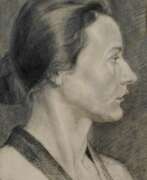

Alois Bergmann-Franken was an academically trained German painter. In the 1930s he began to become known in the Franconian region through his artistic work in the churches. He mastered the fresco technique, encaustic painting, tempera painting and oil painting. By 1965, he had created over 40 depictions of the Way of the Cross in paintings and mosaics, many frescoes and mosaics in churches in Lower Franconia, oil paintings, watercolours, concrete glass windows, woodcuts and sculptures of the Madonna.
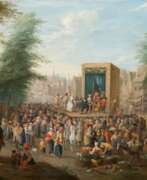

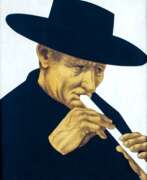

Arne Besser is a contemporary American artist. He received training as an artist at the Art Center School, Los Angeles. There he studied with John Audubon Tyler and Lorser Feidelsson. Beser’s approach to Photo-Realism is to draw from the urban landscape and nature a succinct “set like” image of reality. His city scenes depict New York street life alive with trading and traders, prostitutes and junkies looking for a fix. These visual images iconify the underside of urban life in a way that elevates this point of view to an almost mythic level.
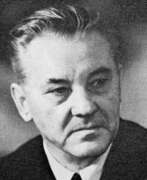

Georgy Nikolaevich Bibikov (Russian: Георгий Николаевич Бибиков) was a Russian and Soviet artist of the mid-20th century. He is known as a painter, graphic artist, illustrator, muralist and theater artist of the Leningrad school, working in the genres of landscape, portrait, still life and thematic painting.
Georgy Bibikov began participating in art exhibitions in 1920. Among his famous works are "Loaders", "Young Red Fleets Receive Uniforms", "Greetings to the Winners", "Trench Truth" and others. His works are in the State Russian Museum and in museums and private collections in Russia, Ukraine, Germany and France.
